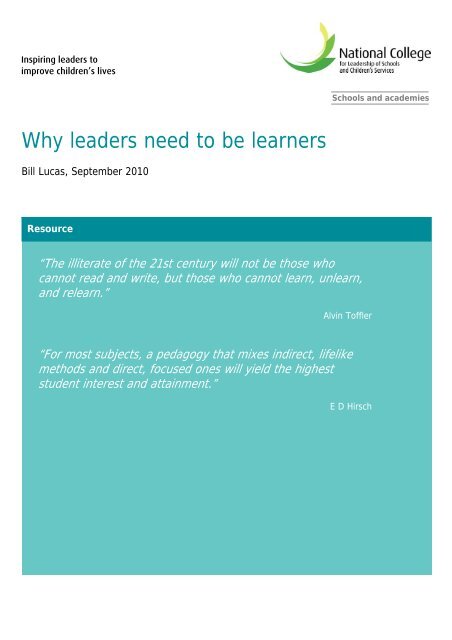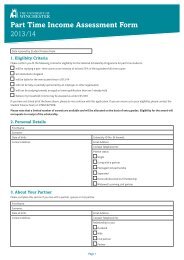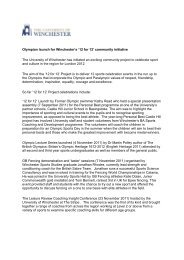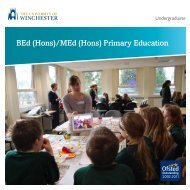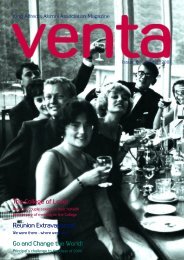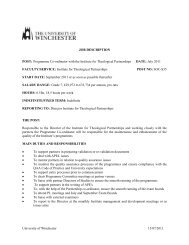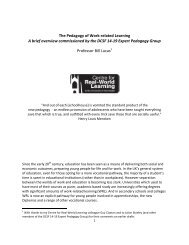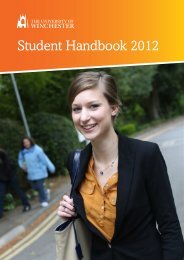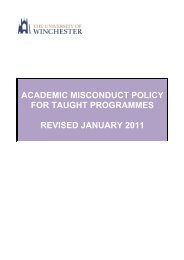Why leaders need to be learners - University of Winchester
Why leaders need to be learners - University of Winchester
Why leaders need to be learners - University of Winchester
Create successful ePaper yourself
Turn your PDF publications into a flip-book with our unique Google optimized e-Paper software.
Inspiring <strong>leaders</strong> <strong>to</strong>improve children’s livesSchools and academies<strong>Why</strong> <strong>leaders</strong> <strong>need</strong> <strong>to</strong> <strong>be</strong> <strong>learners</strong>Bill Lucas, Septem<strong>be</strong>r 2010Resource“The illiterate <strong>of</strong> the 21st century will not <strong>be</strong> those whocannot read and write, but those who cannot learn, unlearn,and relearn.”Alvin T<strong>of</strong>fler“For most subjects, a pedagogy that mixes indirect, lifelikemethods and direct, focused ones will yield the higheststudent interest and attainment.”E D HirschIntroduction
This paper explores some core principles <strong>of</strong> learning, those for which there is strong evidence. It arguesthat school <strong>leaders</strong> <strong>need</strong> <strong>to</strong> have a thorough understanding <strong>of</strong> how children learn so that they canenhance learning outcomes for pupils, develop those staff for whom they are responsible and contribute<strong>to</strong> the creation <strong>of</strong> a culture <strong>of</strong> continuous improvement. A vital part <strong>of</strong> the job <strong>of</strong> a middle leader is <strong>to</strong> <strong>be</strong>a powerful role model demonstrating passion for and active engagement in life-long learning. To do theirjob effectively, middle <strong>leaders</strong> <strong>need</strong> <strong>to</strong> have a good understanding <strong>of</strong> the science as well as the craft <strong>of</strong>learning. They <strong>need</strong> <strong>to</strong> <strong>be</strong> confident that they understand how people learn so that they can teach andcoach others. And they <strong>need</strong> <strong>to</strong> <strong>be</strong> clear that, as well as instilling in young people a deep understanding<strong>of</strong> the subjects that they teach, the role <strong>of</strong> school is <strong>to</strong> prepare people who can learn throughout theirlives whatever they <strong>need</strong> <strong>to</strong> learn. Reading and writing, as Alvin T<strong>of</strong>fler reminds us, while core <strong>to</strong> <strong>be</strong>ingeducated, are necessary but not sufficient elements <strong>of</strong> 21st-century education.2
Learning <strong>to</strong> learn and acquiring knowledgeFor a long while we thought that, while it was possible <strong>to</strong> learn how <strong>to</strong> speak French or <strong>to</strong> solve quadraticequations, it was not possible <strong>to</strong> learn how <strong>to</strong> learn. But in the last 30 years we have <strong>be</strong>gun <strong>to</strong> see thatlearning is itself learnable. Initially referred <strong>to</strong> by the term ‘metacognition’ (Flavell, 1976), we are talkinghere about students’ awareness <strong>of</strong> what is going on as they are learning. For when we aremetacognitively aware, we are noticing what is going on, wondering whether we have selected the <strong>be</strong>stmethod, reflecting on progress made, heeding our emotions while not letting them get the <strong>be</strong>tter <strong>of</strong> us,and adapting the approaches we adopt in the light <strong>of</strong> all <strong>of</strong> this information.Initially, early forms <strong>of</strong> learning <strong>to</strong> learn got in<strong>to</strong> schools in the 1980s via the teaching <strong>of</strong> study skills,<strong>of</strong>ten <strong>to</strong> pupils who <strong>need</strong>ed a crash course <strong>to</strong> get them through tests or examinations or <strong>to</strong> students whowere struggling <strong>to</strong> cope with their lessons. Then it found expression in the 1990s under the banner <strong>of</strong>emotional intelligence as the reper<strong>to</strong>ire <strong>of</strong> cognitive processes was expanded <strong>to</strong> include feeling as well asthinking. In the last decade, through the pioneering work in the UK <strong>of</strong>, for example, Guy Clax<strong>to</strong>n and hisBuilding Learning Power materials (Clax<strong>to</strong>n, 2002), the Campaign for Learning (www.campaign-forlearning.org.uk)and the RSA (www.thersa.org.uk), learning <strong>to</strong> learn has <strong>be</strong>gun <strong>to</strong> take root in schoolswith teachers and school <strong>leaders</strong>. And internationally there are several notable examples <strong>of</strong> good practiceand in some cases widespread reform embracing learning <strong>to</strong> learn as a centrally important process 1 Thething that all <strong>of</strong> these initiatives have in common is that they are increasingly seeking <strong>to</strong> define thedispositions or habits <strong>of</strong> mind (Costa & Kallick, undated) that effective <strong>learners</strong> <strong>need</strong> <strong>to</strong> thrive in <strong>to</strong>day’sworld.Most recently there has <strong>be</strong>en a debate in both the USA and England about the relative importance <strong>of</strong>process skills versus content knowledge. As E D Hirsch put it some while ago: ’To stress critical thinkingwhile de-emphasising knowledge reduces a student’s capacity <strong>to</strong> think critically’. (Hirsch, 1999). Of coursethis is true. Equally, not <strong>to</strong> cultivate critical thinking is patently unhelpful. It is a core role <strong>of</strong> middle<strong>leaders</strong> <strong>to</strong> ensure that neither content knowledge nor learning <strong>to</strong> learn skills are neglected.Activity 1Think about the subject area you know <strong>be</strong>st in your school and the classroom experiences <strong>of</strong> pupils.How confident are you about the subject knowledge <strong>of</strong> the teachers? How do you know this? Howconfident are you about the kinds <strong>of</strong> learning <strong>to</strong> learn skills <strong>be</strong>ing taught? Again, how do you knowthis? Is the balance <strong>be</strong>tween content and process about right?1 See www.pz.harvard.edu/index.cfm,www.nzcurriculum.tki.org.nz/the_new_zealand_curriculum/key_competencies andwww.learning<strong>to</strong>learn.sa.edu.au3
The science <strong>of</strong> learning and schoolimprovementAn important development in recent years has <strong>be</strong>en the realisation that there is a growing body <strong>of</strong>research from various scientific fields which can help us <strong>to</strong> get <strong>be</strong>tter at learning. An important miles<strong>to</strong>nealong the way was the publication by the American National Academies Press, edited by John Bransford,<strong>of</strong> How people learn (Bransford et al, 2000). For the first time, researchers from various scientificdisciplines came <strong>to</strong>gether <strong>to</strong> take s<strong>to</strong>ck <strong>of</strong> what we know about how we learn. Influenced by this and,more recently by work sponsored by the ESRC in the UK (James et al, 2007), in New Zealand 2 and byvarious states in Australia 3 , there is an increasingly evidence-based approach <strong>to</strong> applying the learningsciences in schools.First things first. Let’s <strong>be</strong> absolutely clear. Learning about learning improves performance. Indeed, asChris Watkins puts it, ‘For nearly 20 years it has <strong>be</strong>en known that students with more elaboratedconceptions <strong>of</strong> learning perform <strong>be</strong>tter in public examinations at age 16’ (Watkins et al, 2001; Watkins,2010). This is true <strong>of</strong> the end <strong>of</strong> secondary education and there are many studies making similar pointsfor younger <strong>learners</strong>. In his detailed analysis <strong>of</strong> the impact <strong>of</strong> various teaching and learning methods,John Hattie (2009) goes further still in identifying which aspects <strong>of</strong> learning <strong>to</strong> learn strategies havegreatest impact. General metacognitive strategies (in his words ‘thinking about thinking’) have asignificant effect on attainment, and two in particular – the use <strong>of</strong> self-reported grades by students andthe practice <strong>of</strong> formative evaluation by teachers – have a significant effect.While it is important <strong>to</strong> <strong>be</strong> able <strong>to</strong> talk more precisely about what is going on – for example targets, gapsand so on (indeed this is essential) – such a focus can make it less likely that real improvement happens.For the paradox about getting <strong>be</strong>tter at learning is that if you focus on performance as your goal you areless likely <strong>to</strong> do well than if you adopt a learning orientation.More fundamentally and important philosophically is the view that schools can not only close the gap forstudents by creating the conditions for them <strong>to</strong> <strong>be</strong>come both more effective <strong>learners</strong> and <strong>be</strong>tterexamination achievers, they can also enable students <strong>to</strong> expand their intelligence. Guy Clax<strong>to</strong>n and I haverecently reviewed the evidence for the learnability <strong>of</strong> intelligence in New Kinds <strong>of</strong> Smart: How the science<strong>of</strong> learnable intelligence is changing education (Lucas & Clax<strong>to</strong>n, 2010). It is increasingly clear <strong>to</strong> us thatsustainable school improvement is not just about certain (al<strong>be</strong>it important) <strong>leaders</strong>hip actions; it is alsoinfluenced by deeply entrenched and sometimes mistaken views about intelligence. And the mostcorrosive <strong>of</strong> these myths is the idea that intelligence is almost entirely fixed. For such a <strong>be</strong>lief leadseduca<strong>to</strong>rs <strong>to</strong> conclude that while they may make use <strong>of</strong> what intelligence individual students possess,there is little they can <strong>to</strong> do <strong>to</strong> alter it.Any approaches adopted will <strong>be</strong> limited or thwarted if old and unjustified assumptions about the nature <strong>of</strong>children’s minds and about the nature <strong>of</strong> learning itself are left in place, unexamined. If we were <strong>to</strong> carryon assuming that some children are born intelligent, while others simply do not have the brain-powerrequired <strong>to</strong> master difficult ideas in physics or his<strong>to</strong>ry, say, then the options for change will inevitably <strong>be</strong>limited. If, on the other hand, intelligence is seen as itself learnable, then a whole different set <strong>of</strong>educational possibilities <strong>be</strong>come thinkable.2 See www.nzcurriculum.tki.org.nz/the_new_zealand_curriculum/key_competencies3 See, for example, South Australia’s Learning <strong>to</strong> Learn, www.learning<strong>to</strong>learn.sa.edu.au4
So what assumptions can we make with certainty about learning; what are the principles that underpinworld-class learning? And what are their implications for classroom practice and for the role <strong>of</strong> middle<strong>leaders</strong>? In this paper I will <strong>be</strong> exploring 12 principles drawn from the research literature and inviting you<strong>to</strong> consider how each one might impact on classroom practice and what the implications are for you as amiddle leader.Activity 2Before you turn over this page, see if you can make your own list <strong>of</strong> 12 learning principles, yourown set <strong>of</strong> <strong>be</strong>liefs about learning. Choose those that you think you could defend in terms <strong>of</strong>research you have read or undertaken. You might like <strong>to</strong> use the format ‘Learning is …’. Don’tworry if you cannot come up with as many as 12.Now turn over.5
Key principles <strong>of</strong> learningThis section outlines 12 principles <strong>of</strong> learning. They have <strong>be</strong>en carefully selected, with each one having: good research evidence <strong>to</strong> support it significant implications which middle <strong>leaders</strong> may wish <strong>to</strong> consider a num<strong>be</strong>r <strong>of</strong> practical implications for classroom practiceThere are, <strong>of</strong> course, many more than 12 useful principles that might have an impact. Indeed, part <strong>of</strong>your job as a middle leader is <strong>to</strong> develop a coherent sense <strong>of</strong> what you think is important, drawing onyour own knowledge and experience and matching it <strong>to</strong> your context. The annotated reading list that Ihave produced for the facilitated session on learning provides some other perspectives on which you maywish <strong>to</strong> draw (National College, 2009). In the following pages I take each <strong>of</strong> the principles in turn andexplore it in more detail, sometimes taking the opportunity <strong>to</strong> go a little deeper. At the end <strong>of</strong> each one Iwill <strong>be</strong> inviting you <strong>to</strong> think about your own degree <strong>of</strong> confidence, the implications for classroom practiceand your <strong>leaders</strong>hip role.Key principles <strong>of</strong> learning1. Learning is life-long and part <strong>of</strong> what makes us human.2. Learning and well<strong>be</strong>ing are closely connected.3. Learning works <strong>be</strong>st when the learner’s prior learning is recognised.4. Learning and context are closely linked.5. Becoming an expert learner requires practice.6. Learning that is worthwhile actively engages the learner.7. Learning involves feeling as well as thinking.8. Learning involves social as well as individual processes.9. Learning involves doing as well as thinking.10. Learning requires reflection.11. Learning is influenced by mindset.12. Learning is learnable.6
1. Learning is life-long and part <strong>of</strong> whatmakes us humanAs the quotation with which this paper <strong>be</strong>gins suggests, learning is fundamental <strong>to</strong> our lives. Learningknows no boundaries. What <strong>be</strong>gins in the classroom finds its way on<strong>to</strong> the street and in through the frontdoor <strong>of</strong> the home. Learning is at the heart <strong>of</strong> what it is <strong>to</strong> <strong>be</strong> alive. It is our means <strong>of</strong> making sense <strong>of</strong>experience, <strong>of</strong> adapting <strong>to</strong> new situations and <strong>of</strong> realising our full potential. Schools are the foundation forlife-long learning (Hargreaves, 2004; Clax<strong>to</strong>n & Lucas, 2009).But herein lies a problem. For the learning that we do in our wider lives <strong>of</strong>ten <strong>be</strong>ars little resemblance <strong>to</strong>what we experience in schools. A classic description <strong>of</strong> the difference <strong>be</strong>tween learning in educationalinstitutions and learning elsewhere (at work and at home, for example) was provided by Lauren Resnick(1987) more than 20 years ago. Table 1 adapts Resnick’s thinking <strong>to</strong> show some <strong>of</strong> the most obviousdifferences <strong>be</strong>tween learning in school and learning for life.Table 1Learning in school and collegeLearning at work and at homeOften individualisticLargely using abstract thoughtDecontextualisedExtrinsically motivatedGeneralisedOften collaborativeMainly using practical <strong>to</strong>olsReal contextIntrinsically motivatedSituation-specificSource: Resnick, 1987Of course Table 1 exaggerates the features <strong>of</strong> the two domains. It is perfectly possible for learning in aclassroom <strong>to</strong> <strong>be</strong> highly collaborative just as it is possible for training at work <strong>to</strong> have very low intrinsicmotivational value.Schools that genuinely see their role as laying the foundations for a lifetime <strong>of</strong> learning deli<strong>be</strong>rately seek<strong>to</strong> make connections <strong>be</strong>tween what is <strong>be</strong>ing taught and how it might <strong>be</strong> applied in the real world;studying maps in geography lessons has an obvious connection with using maps on a car journey, forexample. Of course not all learning has an immediate application, but even then it may <strong>be</strong> possible <strong>to</strong>make links. So, a lesson about glaciation may allow you <strong>to</strong> talk about the many vocational opportunitiesfor geographers, from weather forecasting <strong>to</strong> surveying.Question <strong>to</strong> ponderHow well does your school make the link <strong>be</strong>tween what happens in the classroom and whathappens in pupils’ lives outside school? What could you do <strong>to</strong> improve this?7
2. Learning and well<strong>be</strong>ing are closelyconnectedThe self-esteem movement has done such a good job <strong>of</strong> reminding us <strong>of</strong> the importance <strong>of</strong> young<strong>learners</strong> feeling good about themselves that sometimes the research evidence can get hidden. It ispossible <strong>to</strong> <strong>be</strong>come fixated on creating so many opportunities for bolstering pupil confidence that weactually, paradoxically, end up reducing it. Eric Hirsch makes this argument effectively (Hirsch, 1999)where he suggests that praise that is not linked with genuine (he means mainly academic) achievementcan breed complacency or scepticism.There is a complex relationship <strong>be</strong>tween learning, well<strong>be</strong>ing and confidence which <strong>of</strong>ten leads <strong>to</strong>polarised arguments. Do you <strong>need</strong> <strong>to</strong> <strong>be</strong> well in order <strong>to</strong> learn (have enough self-esteem at least)? Or doyou get well by learning (<strong>be</strong>come engaged by trying out worthwhile new things)? Of course, as AbrahamMaslow showed many years ago, we have fundamental <strong>need</strong>s for shelter and <strong>be</strong>longing which <strong>need</strong> <strong>to</strong> <strong>be</strong>met <strong>be</strong>fore we can readily <strong>be</strong>come engaged. But it is through learning challenging and worthwhile thingswith other people that we <strong>be</strong>come really happy. Mihalyi Csikszentmihalyi (1997) calls this the state <strong>of</strong>flow. Real or deep enjoyment seems <strong>to</strong> have a num<strong>be</strong>r <strong>of</strong> ingredients including clear goals, lots <strong>of</strong>feedback, enough challenge for the level <strong>of</strong> skill available and absor<strong>be</strong>d attention in the task at hand. Insuch moments we cannot <strong>be</strong> distracted and lose our sense <strong>of</strong> time. As Csikszentmihalyi puts it: ‘In manyways the secret <strong>to</strong> a happy life is <strong>to</strong> learn <strong>to</strong> get flow from as many <strong>of</strong> the things we do as possible’.Question <strong>to</strong> ponderTo what extent are you and those teachers with whom you work more closely providing sufficientlychallenging and worthwhile opportunities for <strong>learners</strong>? What measures could you routinely use <strong>to</strong><strong>be</strong> able <strong>to</strong> talk with confidence about pupil well<strong>be</strong>ing?8
3. Learning works <strong>be</strong>st when the learner’sprior learning is recognisedWhen we learn we do so by building on what we already know. Once we have experienced something,we <strong>be</strong>gin <strong>to</strong> <strong>be</strong> able <strong>to</strong> have some kind <strong>of</strong> internal sense <strong>of</strong> what it is. Until that time we are simpleprocessing the novel. But we learn by a process <strong>of</strong> adaptation, matching prior experience <strong>to</strong> currentevents or modifying our previously held mental models when current experience does not seem <strong>to</strong> fit withthem. This is what Jean Piaget (1954) meant by the terms ‘assimilation’ and ‘accommodation’.Assimilation is when we fit our experience in<strong>to</strong> a previous theory that we have developed;accommodation is when we adapt our theory in the light <strong>of</strong> experience. So, let’s suppose you had ageneral theory that said ‘all children <strong>be</strong>have well’ then you would simply assimilate positive experiences <strong>of</strong>this mental model. But were the children you knew <strong>to</strong> start <strong>be</strong>having badly, then you would <strong>be</strong> faced witha choice as <strong>to</strong> whether <strong>to</strong> accommodate this new experience and rethink your theory or <strong>to</strong> account forthis contrary experience in some other way (‘they must <strong>be</strong> tired’, ’the task is <strong>to</strong>o difficult’ etc). 4One way <strong>of</strong> harnessing the prior knowledge and experience <strong>of</strong> <strong>learners</strong> is <strong>to</strong> give them a more active rolein teaching aspects <strong>of</strong> a lesson. (Every teacher who has had <strong>to</strong> teach something about which they do notfeel confident knows how effective this is in flushing out exactly what they do or do not know about it.)But it turns out that appropriately engaging pupils in this way has a powerfully positive impact onattainment <strong>to</strong>o: ‘The remarkable feature <strong>of</strong> [all this] evidence is that the biggest effects on studentlearning occur when teachers <strong>be</strong>come <strong>learners</strong> <strong>of</strong> their own teaching, and when students <strong>be</strong>come theirown teachers… Many <strong>of</strong> the most debated issues are the ones with the least effects’ (Hattie, 2009).Unfortunately for teachers, just what pupils know or have already learned is not always clear. But thereare some simple things that every teacher can do. Lessons, especially those that introduce a new <strong>to</strong>pic,can routinely start by asking pupils <strong>to</strong> share what they already know using a range <strong>of</strong> methods. To helppupils successfully accommodate new ideas, teachers can consciously seek <strong>to</strong> <strong>of</strong>fer models, diagrams,rules and formulas as mental models, drawing on their own expert knowledge <strong>of</strong> the subject.Question <strong>to</strong> ponderHow could your school get <strong>be</strong>tter at finding out and then building on the knowledge pupils alreadyhave?4 For a practical exploration <strong>of</strong> accommodation and assimilation, see Lucas (2005).9
4. Learning and context are closely linkedWhen the concept <strong>of</strong> learning <strong>to</strong> learn was first gaining momentum in schools, some teachers made themistake <strong>of</strong> assuming that you could somehow teach pupils how <strong>to</strong> learn at the expense <strong>of</strong> the subjectsthey were studying or that it could <strong>be</strong> learned in isolation, <strong>of</strong>ten in standalone courses. This is rarely thecase. Real learning has a specific context. We understand how a sonnet works and at the same timeimprove our drafting skills or we explore the way molecules interact in different gases while honing ourinvestigative skills.Different contexts also invite different ways <strong>of</strong> doing things. How we learn on a sports field, in a sciencelab or in a drama lesson is heavily influenced by the social situation and by the nature <strong>of</strong> the activity inwhich we are engaged. This field <strong>of</strong> research is sometimes referred <strong>to</strong> as ‘situated learning’ and draws onthe work, for example, <strong>of</strong> Jean Lave and Etienne Wenger (1991). It seeks <strong>to</strong> understand more about how<strong>learners</strong> gain expertise in different contexts, and how they can watch and learn from others who aremore expert than themselves.For middle <strong>leaders</strong> an obvious implication <strong>of</strong> the contextual nature <strong>of</strong> learning is the <strong>need</strong> <strong>to</strong> <strong>be</strong> moresystematic in ensuring that something that is learned in one subject gets used in another lesson andthen, perhaps most importantly, is applied outside school at home and in the wider community. This iswhat is referred <strong>to</strong> as learning transfer and for a long while we have known that it is at the heart <strong>of</strong>effective learning and teaching. But despite a growing understanding <strong>of</strong> the processes involved intransfer, we have <strong>be</strong>en slow <strong>to</strong> utilise this knowledge.Some 20 years ago two researchers, Gavriel Salomon and David Perkins (1989), came up with a reallyuseful way <strong>of</strong> looking at this. They suggested that there are two kinds <strong>of</strong> transfer: low-road and highroad.Low-road transfer is when we you use knowledge and skill learned in one context in anothersituation without really having <strong>to</strong> think about it. So, as a child you learn how <strong>to</strong> sit on a chair but do not<strong>need</strong> <strong>to</strong> <strong>be</strong> taught how <strong>to</strong> sit on logs, on walls or on the floor. You just transfer your basic ‘how <strong>to</strong> sit’expertise naturally, prompted <strong>to</strong> do so by the situation you find yourself in. Or as a car driver you hire avan <strong>to</strong> move your furniture around and find that, although there are some differences in the floppiness <strong>of</strong>the gear lever and the whereabouts <strong>of</strong> the horn, nevertheless the dashboard and general feel <strong>of</strong> the vanprompts you sufficiently <strong>to</strong> recall your car driving skills such that you can transfer them <strong>to</strong> the van.High-road transfer is different. It occurs when learning is used in situations that are different from theoriginal context <strong>of</strong> learning and when whatever you are doing does not prompt you in<strong>to</strong> respondingau<strong>to</strong>matically. So, as an adult faced with a demanding project <strong>to</strong> manage, you manage <strong>to</strong> remem<strong>be</strong>r animportant principle that one <strong>of</strong> your teachers taught you when they encouraged you always <strong>to</strong> set asidetime <strong>to</strong> think about and plan anything that was really important. You therefore apply this <strong>to</strong> the project athand. In fact your teacher, canny person that she or he was, had originally got you <strong>to</strong> think about othersituations in which you might use the ‘planning is essential’ principle, so may<strong>be</strong> it is less surprising thatyou end up doing so. This kind <strong>of</strong> transfer Salomon and Perkins call ‘forward reaching’ (precisely <strong>be</strong>causeit was taught with future application in mind).The other kind <strong>of</strong> high-road transfer – backward looking – requires the learner <strong>to</strong> summon up a learningstrategy from an earlier time and apply it <strong>to</strong> an apparently unrelated context. An example could <strong>be</strong> asituation in your school where you are hugely irritated by another mem<strong>be</strong>r <strong>of</strong> staff and on the point <strong>of</strong>losing your cool when you remem<strong>be</strong>r something that your mother taught you – counting <strong>to</strong> 10 whenunder stress (whether an accident while playing or a tantrum).10
You slowly count <strong>to</strong> 10 and your anger at your colleague subsides. In this case the high-road transfer has<strong>be</strong>en <strong>of</strong> the backward-looking kind.The central issues uncovered by this theory <strong>of</strong> transfer are perfectly expressed in the abstract <strong>to</strong> theirpaper:Low-road transfer depends on extensive, varied practice and occurs by the au<strong>to</strong>matic triggering <strong>of</strong>well-learned <strong>be</strong>haviour in a new context. High-road transfer occurs by intentional mindfulabstraction <strong>of</strong> something from one context and application in a new context.Salomon & Perkins, 1989:In How people learn (Bransford et al, 2000), emerging thinking about learning transfer is helpfullysummarised <strong>to</strong> stress the importance <strong>of</strong> a num<strong>be</strong>r <strong>of</strong> fac<strong>to</strong>rs, including: the <strong>need</strong> for a threshold <strong>of</strong> knowledge time on task and practice learning with understanding rather than learning by rote teaching in varied contexts developing understanding <strong>of</strong> how you might use learning later onIn his most recent book, David Perkins (2009) returns <strong>to</strong> the issue <strong>of</strong> transfer. He descri<strong>be</strong>s two kinds <strong>of</strong>lazy thinking – the Bo Peep or the Lost sheep theories. Bo Peep, like the nursery rhyme, assumes that ifyou leave <strong>learners</strong> (sheep) alone they’ll work it out and return <strong>of</strong> their own accord (‘wagging their tales<strong>be</strong>hind them’). Lost sheep reckons that the whole thing is <strong>to</strong>o complicated <strong>to</strong> waste time on; learning, likesheep, just gets lost along the way. The third way, according <strong>to</strong> Perkins is for teachers <strong>to</strong> play the role <strong>of</strong>‘good shepherd’.There are plenty <strong>of</strong> things that teachers and <strong>leaders</strong> can do <strong>to</strong> ensure the likelihood that they shepherdthe transfer <strong>of</strong> learning (Table 2).Table 2: Low-road versus high-road learning transferLow-road Practise in lots <strong>of</strong> different contexts. Make learning real, not a pale imitation. Role play and imagine different variants. Use real-world problems and issues.High-road Think about future use when you first learn it. Use models, images and rules <strong>to</strong> abstract thelearning. Look for connections all the time. Encourage lots <strong>of</strong> reflection about the process.Question <strong>to</strong> ponderHow might you improve the transfer <strong>of</strong> learning in your school? What can you do <strong>to</strong> help staffteach for transfer? How might thinking about learning transfer affect your role as a middle leader?11
5. Becoming an expert learner requirespracticeEarlier, when looking at the connection <strong>be</strong>tween learning and well<strong>be</strong>ing, we noted the desirability <strong>of</strong>finding optimally challenging tasks for pupils. And we have just <strong>be</strong>en seeing how <strong>to</strong> ensure effectivetransfer, <strong>learners</strong> <strong>need</strong> <strong>to</strong> practise in many different contexts. Learning, in short, requires considerableeffort over a period <strong>of</strong> time.Just how much time is <strong>need</strong>ed and what kinds <strong>of</strong> practice work <strong>be</strong>st is an area <strong>of</strong> learning that is <strong>of</strong>tenneglected in schools. While it may <strong>be</strong> a <strong>to</strong>pic <strong>of</strong> conversation among music and sports teachers it is rarelyshared more generally. Anders Ericsson has suggested that it takes 10,000 hours <strong>to</strong> <strong>be</strong>come an expert inalmost anything (Ericsson et al, 1993) and that certain kinds <strong>of</strong> practice work <strong>be</strong>tter than others.Ericsson has called the kind <strong>of</strong> approaches that work <strong>be</strong>st ‘deli<strong>be</strong>rate practice’. Deli<strong>be</strong>rate practice, as itsname implies, involves identifying the key elements <strong>of</strong> any activity that <strong>need</strong> <strong>to</strong> <strong>be</strong> improved and thenworking systematically on them. This will always require repetition. But repetition that is just mindlessand unfocused may not help. Often it will mean isolating the hard bits and working on them. The morefeedback is available <strong>to</strong> someone practising, the <strong>be</strong>tter, since we practise <strong>be</strong>st when there are cleartargets against which our progress can <strong>be</strong> checked. Ericsson and his colleagues summarises their thinkingas follows:The most cited condition concerns the subjects' motivation <strong>to</strong> attend <strong>to</strong> the task and exert effort <strong>to</strong>improve their performance. In addition, the design <strong>of</strong> the task should take in<strong>to</strong> account thepreexisting knowledge <strong>of</strong> the <strong>learners</strong> so that the task can <strong>be</strong> correctly unders<strong>to</strong>od after a briefperiod <strong>of</strong> instruction. The subjects should receive immediate informative feedback and knowledge<strong>of</strong> results <strong>of</strong> their performance. The subjects should repeatedly perform the same or similar tasks.Ericsson et al, 1993:Of course as any teacher knows, sustaining motivation for constant repetition is extremely challenging.Question <strong>to</strong> ponderHow could you ensure that those teachers with whom you work most closely really understanddeli<strong>be</strong>rate practice and how <strong>be</strong>st <strong>to</strong> integrate it in<strong>to</strong> their classroom practice?12
6. Learning that is worthwhile activelyengages the learnerWe are born curious. We are intrinsically motivated <strong>to</strong> create meaning out <strong>of</strong> our experiences. In facthuman <strong>be</strong>ings are the most highly developed learning organisms on the planet. Yet our enthusiasm fordiscovering new things can wane as we grow older. Such a diminution <strong>of</strong> our learning energy normallyhappens <strong>be</strong>cause <strong>of</strong> a negative thought or feeling (insecurity, fear <strong>of</strong> failure, punishment, <strong>be</strong>ing mockedand so on).The most powerful way <strong>of</strong> redressing this almost inevitable challenge is <strong>to</strong> make learning so worthwhilethat it engages <strong>learners</strong>. As Barbara McCombs puts it: ‘Curiosity, creativity and higher-order thinking arestimulated by relevant, authentic learning tasks <strong>of</strong> optimal difficulty and novelty for each student(McCombs & Whisler, 1997).Underpinning this idea <strong>of</strong> authenticity and active engagement is a growing body <strong>of</strong> knowledge about whatis <strong>of</strong>ten referred <strong>to</strong> as ‘constructivist learning’. At the heart <strong>of</strong> this view <strong>of</strong> learning is the <strong>be</strong>lief thatlearning is an active process in which the learner plays a role in constructing meaning. Some coreprinciples <strong>of</strong> constructivist teaching have <strong>be</strong>en summarised by John Savery and Thomas Duffy (1995):1. Anchor all learning activities <strong>to</strong> a larger task or problem.2. Support the learner in developing ownership for the overall problem or task.3. Design authentic tasks.4. Design the task and the learning environment <strong>to</strong> reflect the complexity <strong>of</strong> the environment inwhich the learner should <strong>be</strong> able <strong>to</strong> function at the end <strong>of</strong> the learning.5. Give the learner ownership <strong>of</strong> the process used <strong>to</strong> develop a solution.6. Design the learning environment <strong>to</strong> support and challenge the learner's thinking.7. Encourage the generation <strong>of</strong> alternative ideas, views and contexts.8. Support opportunities for reflection on both the content learned and the learning processthroughout the learning.Question <strong>to</strong> ponderThis paper starts with a quotation from Eric Hirsch: ‘For most subjects, a pedagogy that mixesindirect, lifelike methods and direct, focused ones will yield the highest student interest andattainment’. Does this make sense <strong>to</strong> you? As a middle leader, how can you balance the <strong>need</strong> forauthentic engagement with the necessity for focused, teacher-led tasks? Take a specific <strong>to</strong>pic youteach and explore this question with it in mind.13
7. Learning involves feeling as well asthinkingWhile we have known for a long while that learning involves thinking, it is only comparatively recentlythat we have woken up <strong>to</strong> the importance <strong>of</strong> emotions – or our affective responses – in our lives. Wehave discovered that, in almost everything that we do, emotions play a significant role. The age <strong>of</strong>enlightenment, when rational thought was the order <strong>of</strong> the day, was so powerful that its influence could<strong>be</strong> felt in education throughout much <strong>of</strong> the 19th and 20th centuries. As a consequence it was not untilthe 1980s through the popularising work <strong>of</strong> Daniel Goleman on emotional intelligence (Goleman, 1996)that workplaces and schools <strong>be</strong>gan <strong>to</strong> legitimise feeling responses <strong>to</strong> life as an integral part <strong>of</strong> thelearning experience.For many years emotion was a nuisance. It interfered with the dispassionate workings <strong>of</strong> reason. Ofcourse this is silly. But the fact the social and emotional aspects <strong>of</strong> learning have only recently <strong>be</strong>enintroduced in<strong>to</strong> both the primary and secondary curriculum is an indication <strong>of</strong> the time it has taken for theemotional aspect <strong>of</strong> learning <strong>to</strong> <strong>be</strong> fully recognised.Question <strong>to</strong> ponderTo what extent are you encouraging both feeling and thinking responses from pupils inclassrooms? When you next observe a lesson, keep a tally <strong>of</strong> how <strong>of</strong>ten pupils are <strong>be</strong>ing invited <strong>to</strong>talk about and analyse their feelings.14
8. Learning involves social as well asindividual processesWe have known that the social elements <strong>of</strong> learning are important for almost a century. Arguably the firstresearch in this area was conducted by Edward Thorndike who, writing in Harper’s Magazine in 1920,talked <strong>of</strong> social intelligence as <strong>be</strong>ing able <strong>to</strong> ‘act wisely in human relations’.Specifically in terms <strong>of</strong> learning, however, it is Lev Vygotsky who helped us <strong>to</strong> see just how much <strong>of</strong>learning is social. In a direct challenge <strong>to</strong> Jean Piaget (who saw young <strong>learners</strong> as only <strong>be</strong>ing able <strong>to</strong> actin certain ways once they had reached specific developmental stages), Vygotsky suggests that sociallearning actually precedes development:Every function in the child’s cultural development appears twice: first on the social level, and later,on the individual level; first <strong>be</strong>tween people (interpsychological) and then inside the child(intrapsychological).Vygotsky, 1978:Knowledge, Vygotsky argues, is something that we construct socially through our interactions with ourpeers and with those who are more knowledgeable than ourselves.Chris Watkins (2005) has taken the idea <strong>of</strong> a community <strong>of</strong> practice and explicitly applied it <strong>to</strong> theclassroom. In a deli<strong>be</strong>rate attempt <strong>to</strong> move away from the paradigm that says ‘learning = <strong>be</strong>ing taught’,he has focused on the fact that the way a classroom is managed is a more significant variable than anyother in terms <strong>of</strong> helping learning (see Wang et al, 1990). Taking this as his starting point, Watkins hassought <strong>to</strong> identify those elements <strong>of</strong> practice in the classroom community that are most <strong>be</strong>neficial forlearning. Watkins descri<strong>be</strong>s three stages in the development <strong>of</strong> learning communities:1. Classrooms as communities, which Watkins descri<strong>be</strong>s as where the teacher is building a sense<strong>of</strong> community in which students are actively engaged and have a chance <strong>to</strong> shape the waythings are organised.2. Classrooms as communities <strong>of</strong> <strong>learners</strong> put the spotlight is on learning (rather than on, say,teaching). There is likely <strong>to</strong> <strong>be</strong> an emphasis on students generating their own questions, highlevels <strong>of</strong> interaction <strong>be</strong>tween students and good levels <strong>of</strong> engagement.3. Classrooms as learning communities places the emphasis on the active creation <strong>of</strong> knowledgeby all concerned, including the teacher. Watkins explains, ‘A classroom run as a learningcommunity operates on the understanding that the growth <strong>of</strong> knowledge involves individualand social processes’. In such contexts <strong>learners</strong> not only take responsibility for themselves andtheir peers but also for what <strong>need</strong>s <strong>to</strong> <strong>be</strong> known.Question <strong>to</strong> ponderTo what extent are you currently developing social intelligence in pupils in your school? Whatmethods or techniques could you introduce <strong>to</strong> your school <strong>to</strong> promote social learning? How can youturn your classrooms and your staff team in<strong>to</strong> learning communities?15
9. Learning involves doing as well asthinkingJust as we once used <strong>to</strong> separate out emotion from reason, so we have for <strong>to</strong>o long taken the doing ou<strong>to</strong>f learning. In real life we think with our hands. Thinking and doing are intertwined. An ac<strong>to</strong>r walksaround <strong>to</strong> help with the learning <strong>of</strong> lines. A sculp<strong>to</strong>r thinks with her hands as she moulds the clay. It turnsout that even doodling improves cognitive performance (Andrade, 2009). As Jacob Bronowski (1974) putit: ‘The hand is the cutting edge <strong>of</strong> the mind’.The new area <strong>of</strong> research that is contributing most <strong>to</strong> this aspect <strong>of</strong> learning is embodied cognition. Thisis demonstrating quite simply that <strong>to</strong> separate practical from theoretical learning is <strong>of</strong>ten unhelpful, forthinking and making are more closely aligned in our minds. Seymour Papert is a key figure in reunitingthinking and making, for it was Papert who realised that Piaget had got it wrong.As children grow up, they do not move from physical learning through imaginary learning and on <strong>to</strong>formal or rational learning, leaving the earlier modes <strong>be</strong>hind as they outgrow them. Quite the reverse: asthey progress, so their capacity for practical learning <strong>be</strong>comes more and more intricate and powerful.Children do not move through stages in a linear way; they develop a richer and deeper reper<strong>to</strong>ire <strong>of</strong>learning strategies which combine thinking and doing (see Papert & Harel, 1991; for a fuller explanation<strong>of</strong> practical intelligence, see Lucas & Clax<strong>to</strong>n, 2010).Question <strong>to</strong> ponderTo what extent are you encouraging both doing and thinking responses from pupils in classrooms?When you next observe a lesson, keep a tally <strong>of</strong> how <strong>of</strong>ten pupils are <strong>be</strong>ing invited <strong>to</strong> undertakepractical rather than thinking tasks. Which do they do more <strong>of</strong>?16
10. Learning requires reflectionReflection is the science <strong>of</strong> living. It is the means by which we extract the learning from our experience inlife and in learning. For while it is smart <strong>to</strong> make mistakes in an attempt <strong>to</strong> learn new and difficult things,<strong>to</strong> make the same mistake repeatedly is dumb.As A A Milne reminds us, it is hard <strong>to</strong> make time <strong>to</strong> s<strong>to</strong>p and think: ‘Here is Edward Bear, comingdownstairs, now, bump, bump, bump, on the back <strong>of</strong> his head <strong>be</strong>hind Chris<strong>to</strong>pher Robin. It is as far as heknows the only way <strong>of</strong> coming downstairs, but somewhere he feels there is another way, if only he coulds<strong>to</strong>p for a moment and think <strong>of</strong> it’ (Milne, 1926).One <strong>of</strong> the most cited authorities in this area is Donald Schön (1983). While Schön’s theory <strong>of</strong> reflectionin-actionhas <strong>be</strong>en highly influential in the design <strong>of</strong> teaching practice for student teachers, and is widelyused in the training <strong>of</strong> other pr<strong>of</strong>essionals such as nurses and care workers, it has not found its way in<strong>to</strong>the classroom.Reflection-in-action is essentially thinking on your feet. So for example, when something unexpectedhappens you might express surprise, but then you might want <strong>to</strong> go back and check something out<strong>be</strong>fore you continue with a particular course <strong>of</strong> action. Schön contrasts reflection-in-action with reflectionon-action,essentially the <strong>of</strong>f-line review function in learning (for example, mulling over why you did whatyou did after the event, and dreaming up <strong>be</strong>tter ways <strong>of</strong> handling the situation next time). Schön’sapproach <strong>to</strong> learning is a kind <strong>of</strong> formative assessment and, therefore, not a million miles away fromapproaches used in assessment for learning (AfL).Question <strong>to</strong> ponderHow do you make time for your own reflection as a leader <strong>to</strong> ensure that you do not end upconstantly ‘bumping your head against the stair’?17
11. Learning is influenced by mindsetWhen it comes <strong>to</strong> accounting for success in learning at school, we normally focus on either effort orattainment. But while it is clear that effort matters, simply trying your <strong>be</strong>st is not enough. And attainmentis all <strong>to</strong>o <strong>of</strong>ten a proxy for intelligence or ability. It turns out that there is a third fac<strong>to</strong>r that is extremelypowerful – mindset. Through the work <strong>of</strong> Carol Dweck (1986; 2006) in particular, we know thatcultivating a growth mindset is one <strong>of</strong> the most important things that a learner can do. Indeed <strong>learners</strong>who adopt this kind <strong>of</strong> mental orientation tend <strong>to</strong> seek challenge, see making mistakes as an inevitablepart <strong>of</strong> the learning process and, above all, <strong>to</strong> see a direct relationship <strong>be</strong>tween the effort they put in andthe rewards they might reap. By contrast, <strong>learners</strong> who acquire a fixed mindset almost inevitably sellthemselves short.For many years it was <strong>be</strong>lieved that intelligence was fixed. This <strong>be</strong>lief is sometimes attributed <strong>to</strong> theinfluence <strong>of</strong> IQ although its inven<strong>to</strong>r, Alfred Binet, did not share this view and actively protested againstthe ‘deplorable verdict that an individual’s intelligence is a fixed quantity’ (Binet, 1909).Over the last 20 or so years, researchers in the USA – Carol Dweck (1986), Lauren Resnick (1987) andDavid Perkins (1995) are three <strong>of</strong> the most significant – have shown that intelligence is indeedexpandable and that a significant element <strong>of</strong> our ability <strong>to</strong> get more intelligent is linked <strong>to</strong> the mindsetswe cultivate.Resnick puts it like this:Students who, over an extended period <strong>of</strong> time are treated as if they are intelligent, actually<strong>be</strong>come more so. If they are taught demanding content, and are expected <strong>to</strong> explain and findconnections… they learn more and learn more quickly. They think <strong>of</strong> themselves as <strong>learners</strong>. Theyare [<strong>be</strong>tter] able <strong>to</strong> bounce back in the face <strong>of</strong> short-term failures.Resnick, 1999:In one study (Blackwell et al, 2007), Dweck <strong>to</strong>ok a group <strong>of</strong> 12-year-olds in New York and, over an 8-week period, spent a <strong>to</strong>tal <strong>of</strong> 3 hours teaching them about the expandability <strong>of</strong> intelligence, showing thattheir brains were more like a growing muscle than something that had a fixed size. She encouraged them<strong>to</strong> see their learning more as a matter <strong>of</strong> effort and strategy than ability. At the end <strong>of</strong> the intervention,their engagement and their mathematical understanding were compared with a group who had <strong>be</strong>entaught about memory strategies – but not about the expandability <strong>of</strong> intelligence – for the same length <strong>of</strong>time. The first group had significantly raised their intelligent engagement with their learning; the secondgroup had not.18
Dweck shows the value <strong>to</strong> young people in terms <strong>of</strong> their attainment and confidence in thinking <strong>of</strong> theirmind as expandable; what she calls a growth mindset. Learners who <strong>be</strong>lieve that their minds, like theirmuscles, are expandable constantly seek <strong>to</strong> improve themselves. They are likely <strong>to</strong> make <strong>be</strong>tter progressand <strong>to</strong> see hard work as a potentially pleasurable activity. Mistakes are also viewed as an indication thatreal learning is taking place.By contrast, <strong>learners</strong> with a fixed mindset tend <strong>to</strong> attribute their success <strong>to</strong> the fact that they were bornclever. These young people are not especially motivated <strong>to</strong> expend effort as they do not <strong>be</strong>lieve that suchan investment is likely <strong>to</strong> <strong>be</strong>ar fruit. If things go wrong repeatedly they can easily seem helpless.If we want <strong>to</strong> cultivate a growth mindset then we <strong>need</strong> <strong>to</strong> surround young people with s<strong>to</strong>ries <strong>of</strong> successborn <strong>of</strong> hard work. We will want <strong>to</strong> seek <strong>to</strong> notice what it was that <strong>learners</strong> did that enabled them <strong>to</strong>improve. The kind <strong>of</strong> metaphors we may want <strong>to</strong> employ when talking about the human mind will,according <strong>to</strong> Dweck, associate it with a learning machine or picture it as having learning muscles. There isnow a growing body <strong>of</strong> research that explicitly connects the possession <strong>of</strong> a growth mindset with successin life and at school (Dweck, 2006).Question <strong>to</strong> ponderWhat can you do <strong>to</strong> cultivate a growth mindset in classrooms? How might Dweck’s researchchange your school’s approach <strong>to</strong> reward, especially the ways in which you praise pupils?19
12. Learning is learnableWe all know that subjects such as French are learnable, as are maths, geography or art. We can alsoclearly learn how <strong>to</strong> chair a meeting, manage our emotions and even <strong>be</strong>come a more effective middleleader. But what about learning? Arguably the most important <strong>of</strong> these 12 principles is the knowledgethat learning is itself learnable. You can get <strong>be</strong>tter at learning 5 and we as teachers and <strong>leaders</strong> can helpyoung people and adults <strong>to</strong> get <strong>be</strong>tter, <strong>to</strong>o.Guy Clax<strong>to</strong>n 6 has developed a really useful <strong>to</strong>ol which at a glance suggests some <strong>of</strong> the ways in whichthis rather abstract principle can manifest itself <strong>to</strong> <strong>learners</strong>. It includes statements such as:I stick at things even when they are hard.It helps <strong>to</strong> understand if I put myself in other people’s shoes.I plan my learning carefully.I can change tack when I’m learning if <strong>need</strong>s <strong>be</strong>.I learn well as part <strong>of</strong> a team.Statements like these help pupils (and teachers) <strong>to</strong> keep track <strong>of</strong> their progress as <strong>learners</strong>. They alsohelp <strong>to</strong> expand their reper<strong>to</strong>ire <strong>of</strong> vocabulary when it comes <strong>to</strong> talking about their development.Activity 3Go back through each <strong>of</strong> the 12 principles and create a learner statement similar <strong>to</strong> the ones listedabove, turning each principle in<strong>to</strong> a practical expression <strong>of</strong> confidence.If you were taking principle 11, for example, it might <strong>be</strong> something like: ‘You can improve howintelligent you are by hard work.’5 See, for example, research by the Campaign for Learning and by the ESRC-funded Learning how <strong>to</strong>Learn research project in classrooms, schools and networks.6 See www.tloltd.co.uk/buildinglearningpower.php20
The 4-6-1 model <strong>of</strong> learningThe 4-6-1 model <strong>of</strong> learning is published in Clax<strong>to</strong>n et al (2010) and is a development <strong>of</strong> one descri<strong>be</strong>d inLucas & Clax<strong>to</strong>n (2010). At the Centre for Real-World Learning we have <strong>be</strong>en trying <strong>to</strong> move from theoryin<strong>to</strong> practice and <strong>to</strong> help us do this we have developed a model <strong>of</strong> learning which we hope may provepractically useful for teachers (Figure 1).It is very much a work in progress and I <strong>of</strong>fer it here as a means <strong>of</strong> structuring a final activity in whichyou can take an aspect <strong>of</strong> learning in which you are particularly interested and develop your own thinkingin greater depth.Figure 1: The 4-6-1 model <strong>of</strong> learningframesquestioningcuriosityoptimismwisdom(finding out)investigatinghabits(trying out)experimentingdeterminationmotivationalclarityvaluesreflectionattending/copying(dreaming up)imagininginvestigatingpresence <strong>of</strong> mindpractising/drafting(thinkingthrough)reasoningresilienceriskpatienceresourcefulnesspossibilityself-coachingvisualising/dreaminganalysing/explaining<strong>to</strong>olsresourcesICTcommunicatingsociabilitycommunities <strong>of</strong>practice21
In the inner ring we have put what we think <strong>of</strong> as the four core elements <strong>of</strong> a learner’s <strong>to</strong>olkit,investigating, experimenting, imagining and reasoning. We have borrowed the phrase ‘habits <strong>of</strong> mind’from Art Costa and Bena Kallick (undated) <strong>to</strong> descri<strong>be</strong> these.Investigating means <strong>be</strong>ing good at finding out. This may involve searching, finding, collating andevaluating information. It requires powers <strong>of</strong> observation, contemplation, concentration andattention. It takes perceptiveness with regard <strong>to</strong> details and patterns.Experimenting means crafting, tinkering and trying things out. It involves attempting <strong>to</strong> improveproducts and performances. It takes the skills <strong>of</strong> practising, playing, improvising as well asau<strong>to</strong>mating and refining. It requires individuals <strong>to</strong> <strong>be</strong> able <strong>to</strong> get the <strong>be</strong>st out <strong>of</strong> whateverresources are available.Imagining means making use <strong>of</strong> our inner theatre. It takes skilled mental rehearsal andvisualisation. It calls on the use <strong>of</strong> analogies and metaphors and involves giving space for theprompts, hunches and inklings <strong>of</strong> our intuition.Reasoning means thinking things through carefully. It takes methodical fault-tracing and logicalproblem-solving. It requires the use <strong>of</strong> language and symbols <strong>to</strong> descri<strong>be</strong> and reason. It involvesdeduction, rational link-making, reasoned analysis and argument. It <strong>need</strong>s effective use <strong>of</strong>knowledge and theory <strong>to</strong> construct explanations.Six frames <strong>of</strong> mind – the dispositions and attitudes that support the central four habits <strong>of</strong> mind – sit inthe outer ring <strong>of</strong> Figure 1. These are curiosity, determination, resourcefulness, sociability, reflection andwisdom.Curiosity involves having an inquisitive attitude, <strong>be</strong>ing open <strong>to</strong> wonder and puzzlement, <strong>be</strong>ing full<strong>of</strong> questions. It is driven by a desire <strong>to</strong> get <strong>be</strong>low the surface <strong>of</strong> things and by scepticism <strong>to</strong>wardsconventional truths and knowledge claims. It is bolstered by a sense <strong>of</strong> optimism and <strong>be</strong>lief in theefficacy <strong>of</strong> learning.Determination involves resilience and persistence in the face <strong>of</strong> difficulty. It requires <strong>to</strong>lerance <strong>of</strong>effort, confusion and error. It calls for patience, a willingness <strong>to</strong> try new things and take risks and a<strong>be</strong>lief in the expandability <strong>of</strong> abilities and ability itself.Resourcefulness involves alertness <strong>to</strong> the resource possibilities <strong>of</strong> space, people and materials. Itrequires the collection, cus<strong>to</strong>misation, manufacture, maintenance and use <strong>of</strong> <strong>to</strong>ols <strong>of</strong> all kinds.Sociability involves an openness <strong>to</strong> questioning and discussion, and <strong>be</strong>ing able <strong>to</strong> hold one’s own indebate whilst staying open-minded. It calls on collaboration and conviviality as a team player. Itrequires the skilled giving and receiving <strong>of</strong> feedback.Reflection involves taking a step back <strong>to</strong> consider strategic options, and <strong>be</strong>ing your own teacher. Itcalls for self-awareness rather than self-consciousness. It draws on memories and s<strong>to</strong>redimpressions.22
Wisdom involves knowing what is true and what really matters, and developing a good sense <strong>of</strong>one’s own passions, vocations and interests. It requires self-direction and intrinsic motivation. Itcalls on individuals <strong>to</strong> cherish their own identity as a growing expert and <strong>to</strong> experience the quietpride <strong>of</strong> a job well done.At the centre <strong>of</strong> our model is presence <strong>of</strong> mind.Presence <strong>of</strong> mind is the core <strong>of</strong> real-world intelligence. This is where the learner brings his or hermind fully <strong>to</strong> <strong>be</strong>ar on the learning, deciding how <strong>to</strong> deploy resources optimally.Activity 4In pairs, talk about the 4-6-1 model. What do you like? What is missing?Now choose one <strong>of</strong> the four habits or six frames <strong>of</strong> mind.Select a <strong>to</strong>pic or subject that you both teach (or at least that one <strong>of</strong> you knows and can act as acontext for the activity).How could you blend content and process <strong>to</strong> ensure that knowledge and learning skills aredeveloped? Sketch out your thinking on paper.How could you use the 4-6-1 model as the focus <strong>of</strong> in-service training (Inset) in your school?23
Middle <strong>leaders</strong> and learningMiddle <strong>leaders</strong> have a vital role in leading learning, for they sit at the interface <strong>of</strong> pupil and staff learning.Middle <strong>leaders</strong> who understand and apply a rich understanding <strong>of</strong> learning 7 will significantly contribute <strong>to</strong>the performance <strong>of</strong> their school and the chances <strong>of</strong> success in life <strong>of</strong> their pupils. This will <strong>be</strong> evident intheir own teaching, in the way they approach curriculum planning and organisation, in the way they talk<strong>to</strong> children and young people, in their approach <strong>to</strong> staff development and, above all, through the waythey act as learning role models.Middle <strong>leaders</strong> also have a real opportunity <strong>to</strong> contribute <strong>to</strong> the creation <strong>of</strong> a school that has a real culture<strong>of</strong> learning, where experimentation is encouraged and where learning is really unders<strong>to</strong>od. Middle<strong>learners</strong> will, at different times, model each and every element <strong>of</strong> the 4-6-1 model we have <strong>be</strong>endescribing and they will have strategies for cultivating each <strong>of</strong> the different elements in others.Leading from the middle is challenging and exciting, for middle <strong>leaders</strong> have multiple roles. On the onehand having curriculum and/or pas<strong>to</strong>ral responsibility and oversight, and on the other still with a foot inthe classroom, you have a unique opportunity <strong>to</strong> influence colleagues and pupils alike. It is through themiddle <strong>leaders</strong>hip <strong>of</strong> a school that a genuine culture <strong>of</strong> learning can <strong>be</strong> developed and em<strong>be</strong>dded. Schoolswhere teachers combine high levels <strong>of</strong> subject expertise with a sophisticated understanding <strong>of</strong> learningare playing a major role in raising standards and overcoming social inequality.The habits <strong>of</strong> mind you adopt as a leader will <strong>be</strong> critically important in determining whether and how yourschool really has a culture <strong>of</strong> learning. Of course you will have <strong>to</strong> engage in the mechanisms <strong>of</strong> schoolimprovement and accountability, a given <strong>of</strong> contemporary education. But how much you genuinely<strong>be</strong>come involved in cultivating the habits <strong>of</strong> mind <strong>of</strong> effective <strong>learners</strong>, modelling these yourself, noticingthem in others, talking about them and providing opportunities for children and adults <strong>to</strong> stretch theirlearning muscles will <strong>be</strong> the true test <strong>of</strong> your commitment <strong>to</strong> learning.Exactly what the wider skills or habits <strong>of</strong> mind are has <strong>be</strong>en written about extensively elsewhere (Lucas,2001; Clax<strong>to</strong>n, 2002; Lucas & Clax<strong>to</strong>n, 2009). But I want <strong>to</strong> end with just four which I <strong>be</strong>lieve <strong>to</strong> <strong>be</strong> core.From research I have undertaken in the context <strong>of</strong> Alder Hey children’s hospital in Liverpool (Lucas &Buckley, 2009), I suggest that these four attitudes are critical:1. Improvement focused – skilled in the science <strong>of</strong> learning and always talking about improvinglearning even when very busy2. Questioning – What are we improving? <strong>Why</strong> are we doing it? How are we doing it? How do weknow if it is helping <strong>to</strong> make improvements? Who else is doing it well?3. Facilitating – actively engaging others, always showing that ‘we’ are stronger than ‘I’4. Empowering – demonstrating, observing, sharing and men<strong>to</strong>ring othersEach <strong>of</strong> them <strong>be</strong>gs a num<strong>be</strong>r <strong>of</strong> questions, with which I leave you.Questions <strong>to</strong> ponderHow do you know if children are <strong>be</strong>coming <strong>be</strong>tter <strong>learners</strong>? What are the most important thingsthat middle <strong>leaders</strong> can do <strong>to</strong> improve the quality <strong>of</strong> learning? How will you know if they areworking? How can you develop a culture <strong>of</strong> genuine enquiry where questioning is trulyencouraged? What examples can you think <strong>of</strong> where your own style <strong>of</strong> <strong>leaders</strong>hip is at its mostfacilitative and empowering?7 An understanding <strong>of</strong> learning how <strong>to</strong> learn is a key element highlighted in West-Burnham (2009).24
Acknowledgements and referencesI am grateful, as ever, <strong>to</strong> my friend and colleague Pr<strong>of</strong>essor Guy Clax<strong>to</strong>n, Co-Direc<strong>to</strong>r <strong>of</strong> the Centre forReal-World Learning. Many <strong>of</strong> the ideas here have emerged from our joint working and facilitating,recently published as Lucas & Clax<strong>to</strong>n (2010) New kinds <strong>of</strong> smart: How the science <strong>of</strong> expandableintelligence is changing education and Clax<strong>to</strong>n, Lucas & Webster (2010) Bodies <strong>of</strong> Knowledge.Andrade, J, 2009, What does doodling do? Applied Cognitive Psychology, 24(1), January, 100-6Binet, A, 1909, Les Idées Modernes sur les Enfants, Paris, FlammarionBlackwell, L, Trzesniewski, K & Dweck, C, 2007, Implicit theories <strong>of</strong> intelligence predict achievementacross an adolescent transition: a longitudinal study and intervention, Child Development, 78(1), 246-63Bransford, J D, Brown, A L & Cocking, R R (eds) & The Committee on Learning Research and EducationalPractice, 2000, How people learn: Brain, mind, experience, and school, Washing<strong>to</strong>n, National AcademiesPressBronowski, J, 1974, The Ascent <strong>of</strong> Man, London, Little, BrownClax<strong>to</strong>n, G, 2002, Building learning power: Helping young people <strong>be</strong>come <strong>be</strong>tter <strong>learners</strong>, Bris<strong>to</strong>l, TheLearning Organisation LtdClax<strong>to</strong>n, G & Lucas, B, 2009, School as a foundation for lifelong learning: the implications <strong>of</strong> a lifelonglearning perspective for the re-imagining <strong>of</strong> school-age education, Inquiry in<strong>to</strong> the Future <strong>of</strong> LifelongLearning (IFLL) sec<strong>to</strong>r paper 1, Leicester, National Institute <strong>of</strong> Adult and Continuing EducationClax<strong>to</strong>n, G, Lucas, B & Webster, R, 2010, Bodies <strong>of</strong> Knowledge, London, EdgeCosta, A & Kallick, B, 2000, Discovering and Exploring Habits <strong>of</strong> Mind, Alexandria, VA, ASCDCsikszentmihalyi, M, 1997, Creativity: Flow and the psychology <strong>of</strong> discovery and invention, New York,HarperPerennialDweck, C, 2006, Success: The new psychology <strong>of</strong> success, New York, Ballantine BooksDweck, C, 1986, Motivational processes affecting learning, American Psychologist, 41, 1040-48Ericsson, A, Krampe, R T & Tesch-Römer, T, 1993, The role <strong>of</strong> deli<strong>be</strong>rate practice in the acquisition <strong>of</strong>expert performance, Psychological Review 100(3), 363-406Flavell, J, 1976, Metacognitive aspects <strong>of</strong> problem-solving. In Resnick, L (ed), The nature <strong>of</strong> intelligence,N J Erlbaum, HillsdaleGoleman, D, 1996, Emotional Intelligence: <strong>Why</strong> it can matter more than IQ, New York, BloomsburyHargreaves, D, 2004, Learning for Life: The foundations <strong>of</strong> lifelong learning, Bris<strong>to</strong>l, The Policy PressHattie, J, 2009, Visible Learning: A synthesis <strong>of</strong> over 800 meta-analyses relating <strong>to</strong> achievement, Oxford,RoutledgeHirsch, E D, 1999, The schools we <strong>need</strong> and why we don’t have them, New York, Anchor BooksJames, M, McCormick, R, Black, P, Carmichael, P, Drummond, M-J, Fox, A, MacBeath, J, Marshall, B,Pedder, D, Procter, R, Swaffield, S, Swann, J & William, D, 2007, Improving learning how <strong>to</strong> learn:Classrooms, schools and networks, London, RoutledgeLave, J & Wenger, E, 1991, Situated Learning: Legitimate peripheral participation, Cambridge, Cambridge<strong>University</strong> PressLucas, B, 2005, Discover your hidden talents: The essential guide <strong>to</strong> lifelong learning, Stafford, NetworkEducational PressLucas, B, 2001, Power up your mind: Learn faster, work smarter, Nicholas Brealey, London25
Lucas, B & Buckley, T, 2009, Leadership for quality improvement; what does it really take? TheInternational Journal <strong>of</strong> Leadership in Public Services, 5(1), March, 37-46Lucas, B & Clax<strong>to</strong>n, G, 2010, New Kinds <strong>of</strong> Smart: How the science <strong>of</strong> expandable intelligence is changingeducation, Buckingham, Open <strong>University</strong> PressLucas, B & Clax<strong>to</strong>n, G, 2009, Wider skills for learning: What are they, how can they <strong>be</strong> cultivated, howcould they <strong>be</strong> measured and why are they important for innovation? London, National Endowment forScience, Technology and the ArtsMcCombs, B & Whisler, J S, 1997, The learner-centred classroom and school: Strategies for increasingstudent motivation and achievement, San Francisco, Jossey-BassMilne, A A, 1926, Winnie the Pooh, London, Heinemann Young BooksNational College, 2009, Leading Learning: A reading list for middle <strong>leaders</strong>, Nottingham, National Collegefor Leadership <strong>of</strong> Schools and Children’s ServicesPapert, S & Harel, I, 1991, Constructionism, Norwood, Ablex PublishingPerkins, D, 2009, Making Learning Whole: How seven principles <strong>of</strong> teaching can transform education, SanFrancisco, Jossey-BassPerkins, D, 1995, Outsmarting IQ: The emerging science <strong>of</strong> expandable intelligence, New York, Simon &SchusterPiaget, J, 1954, The construction <strong>of</strong> reality in the child, London, Routledge & Kegan PaulResnick, L, 1999, Making America smarter, Education Week Century Series, 18(40), 38-40Resnick, L, 1987, Learning in school and out, Educational Researcher, 16, 13-40Salomon, G & Perkins, D N, 1989, Rocky roads <strong>to</strong> transfer: rethinking the mechanism <strong>of</strong> a neglectedphenomenon, Educational Psychologist, 24(2), 113-42Savery, J & Duffy, T, 1995, Problem-based learning: an instructional model and its constructivistframework, Educational Technology, 35, 31-8Schön, D, 1983, Reflective Practitioner: How pr<strong>of</strong>essionals think in action, London, Temple SmithVygotsky, L S, 1978, Mind and society: The development <strong>of</strong> higher mental processes, Cambridge, MA,Harvard <strong>University</strong> PressWang, M, Haertel, G & Wal<strong>be</strong>rg, H, 1990, What influences learning: a content analysis <strong>of</strong> reviewliterature, Journal <strong>of</strong> Educational Research, 84(1), 30-43Watkins, C, 2010, Learning, performance and improvement, London, International Network for SchoolImprovement no. 34Watkins, C, 2005, Classrooms as learning communities: a review <strong>of</strong> research, London Review <strong>of</strong>Education 3(1), March, 47-64Watkins, C with Carnell, E, 2001, Learning about learning enhances performance, London, NationalSchool Improvement Network no. 13West-Burnham, J, 2009, Leadership for personalising learning, Nottingham, National College Leadership<strong>of</strong> Schools and Children’s Services26
The National College is the firstpr<strong>of</strong>essional body uniquely dedicated<strong>to</strong> developing and supporting aspiringand serving <strong>leaders</strong> in schools, earlyyears settings and children’s services.The College gives its mem<strong>be</strong>rs thepr<strong>of</strong>essional development and recognitionthey <strong>need</strong> <strong>to</strong> build their careers andsupport those they work with. Mem<strong>be</strong>rsare part <strong>of</strong> a community <strong>of</strong> thousands <strong>of</strong>other <strong>leaders</strong> – exchanging ideas, sharinggood practice and working <strong>to</strong>gether <strong>to</strong>make a bigger difference for childrenand young people.©2010 National College for Leadership <strong>of</strong> Schoolsand Children’s Services – All rights reserved.No part <strong>of</strong> this document may <strong>be</strong> reproducedwithout prior permission from the National College.To reuse this material, please contact the Marketingand Communications Team at the National Collegeor email publications@nationalcollege.org.ukTriumph RoadNottingham NG8 1DHT 0845 609 0009F 0115 872 2001E enquiries@nationalcollege.org.ukwww.nationalcollege.org.ukPB775


